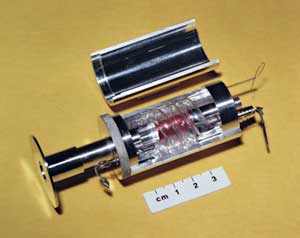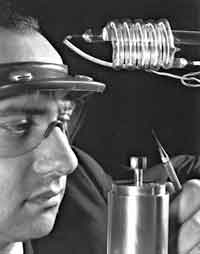Theodore Maiman and the Laser
Dr. Theodore “Ted” Maiman’s laser—the world’s first working laser—represented a major breakthrough in the field of applied physics. Today, the amplification of light resulting from a laser is used for a variety of activities ranging from surgery to weaponry.
The development of the laser can be traced to Albert Einstein’s concept of “stimulated emission of radiation,” which he put forth in a paper delivered in 1916. But it was a paper on laser theory published in 1958 by two physicists, Charles Townes and Arthur L. Schawlow, that spurred the race to build the first working laser. After the publication of Townes and Schawlow’s paper, physicists across the world scrambled to make Townes and Schawlow’s theory reality. Huge government grants, primarily from the Pentagon’s Defense Advanced Research Projects Agency, were poured into corporate laboratories and public and private universities across the United States to fund the project. But it was a lone physicist at Hughes Electric Corporation in California, working against the wishes of his bosses and against general opinion among physicists that his ideas would never work, who created the first working laser. That man was Theodore Maiman.
Maiman developed a laser that was made out of ruby, which has a high chromium content, and absorbs green and blue light while emitting red light. By flashing white light into a cylinder of ruby, Maiman energized the electrons in the chromium. The energized green and blue wavelengths were absorbed and then amplified the red wavelengths until the light pulse of the ruby was amplified to high power, resulting in a laser. Prior to Maiman’s discovery, physicists had denounced the idea that ruby could work in creating lasers. All were stunned when Maiman published his results in the British weekly Nature in August 1960. Some physicists, however, downplayed the significance of Maiman’s discovery. Maiman took strong offense to this snub. The rather cool response he received, Maiman has said, was in part the result of his being a latecomer to the field of laser development. There was a feeling that he had stolen the show from others who had done the real work. Still, virtually all recognized the event as a major breakthrough and today, Maiman is highly regarded for his contribution to laser technology.
One of Maiman’s greatest contributions to the field of laser technology was his demonstration of the ease with which lasers could be constructed, making them of great practical use.
With Maiman’s successful test of the first laser, a laser boom began. By 1961, the first commercial laser hit the market. Maiman left his job at Hughes to form a commercial laser company, Quantatron. Laser technology increased as rapidly as the commercial laser industry. Fast on the heels of Maiman’s laser came the dye laser, the helium-neon laser, the semi-conductor laser, the carbon-dioxide laser, the ion laser, the metal-vapor laser, the excimer laser, and the free-electron laser.

